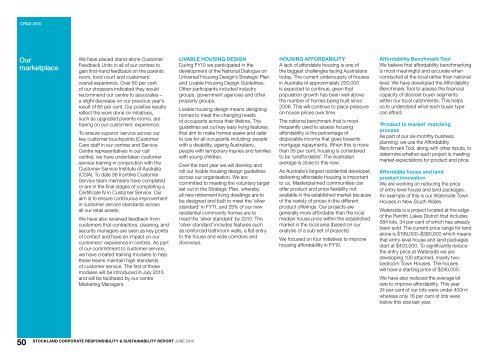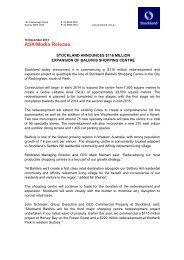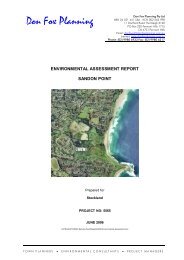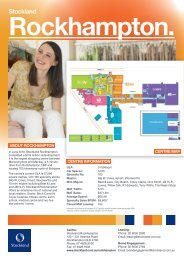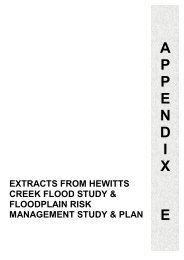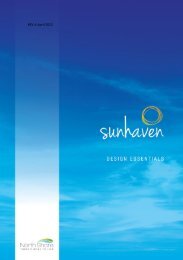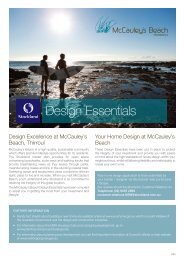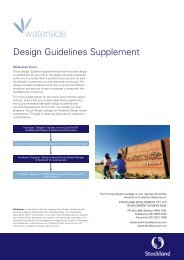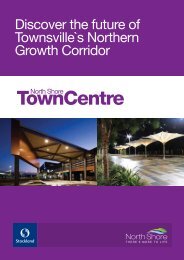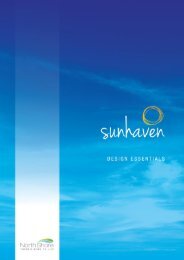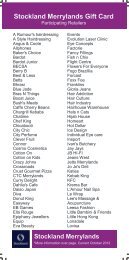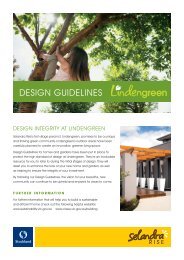Download PDF - Stockland
Download PDF - Stockland
Download PDF - Stockland
Create successful ePaper yourself
Turn your PDF publications into a flip-book with our unique Google optimized e-Paper software.
CR&S 2010<br />
Our<br />
marketplace<br />
We have placed stand-alone Customer<br />
Feedback Units in all of our centres to<br />
gain first-hand feedback on the parents<br />
room, food court and customers’<br />
overall experience. Over 60 per cent<br />
of our shoppers indicated they would<br />
recommend our centre to associates –<br />
a slight decrease on our previous year’s<br />
result of 65 per cent. Our positive results<br />
reflect the work done on initiatives,<br />
such as upgraded parents rooms, are<br />
having on our customers’ experience.<br />
To ensure superior service across our<br />
key customer touchpoints (Customer<br />
Care staff in our centres and Service<br />
Centre representatives in our call<br />
centre), we have undertaken customer<br />
service training in conjunction with the<br />
Customer Service Institute of Australia<br />
(CSIA). To date 36 frontline Customer<br />
Service team members have completed<br />
or are in the final stages of completing a<br />
Certificate IV in Customer Service. Our<br />
aim is to ensure continuous improvement<br />
in customer service standards across<br />
all our retail assets.<br />
We have also received feedback from<br />
customers that contractors, cleaning, and<br />
security managers are seen as key points<br />
of contact and have an impact on our<br />
customers’ experience in centres. As part<br />
of our commitment to customer service,<br />
we have created training modules to help<br />
these teams maintain high standards<br />
of customer service. The first of these<br />
modules will be introduced in July 2010<br />
and will be facilitated by our centre<br />
Marketing Managers.<br />
Livable housing design<br />
During FY10 we participated in the<br />
development of the National Dialogue on<br />
Universal Housing Design’s Strategic Plan<br />
and Livable Housing Design Guidelines.<br />
Other participants included industry<br />
groups, government agencies and other<br />
property groups.<br />
Livable housing design means designing<br />
homes to meet the changing needs<br />
of occupants across their lifetime. The<br />
guidelines set out key easy living features<br />
that aim to make homes easier and safer<br />
to use for all occupants including: people<br />
with a disability, ageing Australians,<br />
people with temporary injuries and families<br />
with young children.<br />
Over the next year we will develop and<br />
roll out livable housing design guidelines<br />
across our organisation. We are<br />
committed to meeting the voluntary target<br />
set out in the Strategic Plan, whereby<br />
all new retirement living dwellings are to<br />
be designed and built to meet the ‘silver<br />
standard’ in FY11, and 25% of our new<br />
residential community homes are to<br />
meet the ‘silver standard’ by 2013. The<br />
‘silver standard’ includes features such<br />
as reinforced bathroom walls, a flat entry<br />
to the house and wide corridors and<br />
doorways.<br />
Housing Affordability<br />
A lack of affordable housing is one of<br />
the biggest challenges facing Australians<br />
today. The current undersupply of houses<br />
in Australia of approximately 200,000<br />
is expected to continue, given that<br />
population growth has been well above<br />
the number of homes being built since<br />
2006. This will continue to place pressure<br />
on house prices over time.<br />
The national benchmark that is most<br />
frequently used to assess housing<br />
affordability is the percentage of<br />
disposable income that goes towards<br />
mortgage repayments. When this is more<br />
than 35 per cent, housing is considered<br />
to be ‘unaffordable’. The Australian<br />
average is close to this now.<br />
As Australia’s largest residential developer,<br />
delivering affordable housing is important<br />
to us. Masterplanned communities can<br />
offer product and price flexibility not<br />
available in the established market because<br />
of the variety of prices in the different<br />
product offerings. Our projects are<br />
generally more affordable than the local<br />
median house price within the established<br />
market in the local area (based on our<br />
analysis of a sub-set of projects).<br />
We focused on four initiatives to improve<br />
housing affordability in FY10.<br />
Affordability Benchmark Tool<br />
We believe that affordability benchmarking<br />
is most meaningful and accurate when<br />
conducted at the local rather than national<br />
level. We have developed the Affordability<br />
Benchmark Tool to assess the financial<br />
capacity of discreet buyer segments<br />
within our local catchments. This helps<br />
us to understand what each buyer type<br />
can afford.<br />
‘Product to market’ matching<br />
process<br />
As part of our six-monthly business<br />
planning, we use the Affordability<br />
Benchmark Tool, along with other inputs, to<br />
determine whether each project is meeting<br />
market expectations for product and price.<br />
Affordable house and land<br />
product innovation<br />
We are working on reducing the price<br />
of entry level house and land packages.<br />
An example of this is our Waterside Town<br />
Houses in New South Wales.<br />
Waterside is a project located at the edge<br />
of the Penrith Lakes District that includes<br />
584 lots, 34 per cent of which has already<br />
been sold. The current price range for land<br />
alone is $199,000–$280,000 which means<br />
that entry-level house and land packages<br />
start at $400,000. To significantly reduce<br />
the entry price at Waterside we are<br />
developing 100 attached, mainly twobedroom<br />
Town Houses. The houses<br />
will have a starting price of $290,000.<br />
We have also reduced the average lot<br />
size to improve affordability. This year<br />
24 per cent of our lots were under 400m 2<br />
whereas only 16 per cent of lots were<br />
below this size last year.<br />
50<br />
<strong>Stockland</strong> Corporate Responsibility & Sustainability Report June 2010


